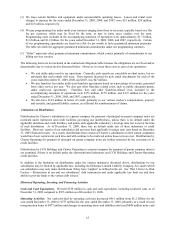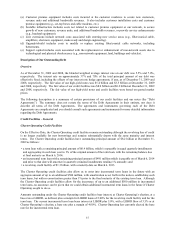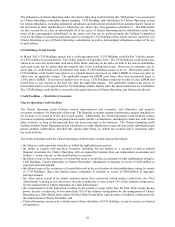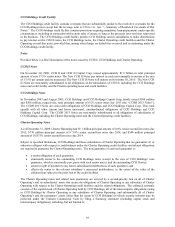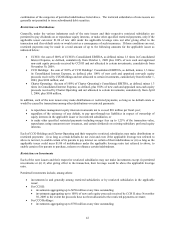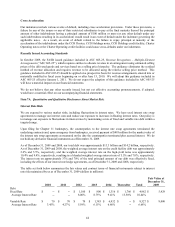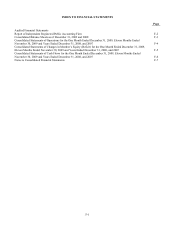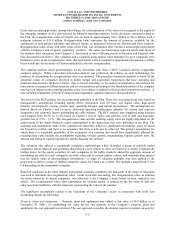Charter 2009 Annual Report Download - page 47
Download and view the complete annual report
Please find page 47 of the 2009 Charter annual report below. You can navigate through the pages in the report by either clicking on the pages listed below, or by using the keyword search tool below to find specific information within the annual report.
44
Cross Acceleration
Our indentures include various events of default, including cross acceleration provisions. Under these provisions, a
failure by any of the issuers or any of their restricted subsidiaries to pay at the final maturity thereof the principal
amount of other indebtedness having a principal amount of $100 million or more (or any other default under any
such indebtedness resulting in its acceleration) would result in an event of default under the indenture governing the
applicable notes. As a result, an event of default related to the failure to repay principal at maturity or the
acceleration of the indebtedness under the CCH II notes, CCO Holdings notes, CCO Holdings credit facility, Charter
Operating notes or the Charter Operating credit facilities could cause cross-defaults under our indentures.
Recently Issued Accounting Standards
In October 2009, the FASB issued guidance included in ASC 605-25, Revenue Recognition – Multiple-Element
Arrangements (“ASC 605-25”), which requires entities to allocate revenue in an arrangement using estimated selling
prices of the delivered goods and services based on a selling price hierarchy. The guidance eliminates the residual
method of revenue allocation and requires revenue to be allocated using the relative selling price method. This
guidance included in ASC 605-25 should be applied on a prospective basis for revenue arrangements entered into or
materially modified in fiscal years beginning on or after June 15, 2010. We will adopt this guidance included in
ASC 605-25 effective January 1, 2011. We do not expect the adoption of this guidance included in ASC 605-25
will have a material impact on our financial statements.
We do not believe that any other recently issued, but not yet effective accounting pronouncements, if adopted,
would have a material effect on our accompanying financial statements.
Item 7A. Quantitative and Qualitative Disclosures About Market Risk.
Interest Rate Risk
We are exposed to various market risks, including fluctuations in interest rates. We have used interest rate swap
agreements to manage our interest costs and reduce our exposure to increases in floating interest rates. Our policy is
to manage our exposure to fluctuations in interest rates by maintaining a mix of fixed and variable rate debt within a
targeted range.
Upon filing for Chapter 11 bankruptcy, the counterparties to the interest rate swap agreements terminated the
underlying contracts and, upon emergence from bankruptcy, received payment of $495 million for the market value of
the interest rate swap agreements as measured on the date the counterparties terminated plus accrued interest. We do
not hold any derivative financial instruments as of December 31, 2009.
As of December 31, 2009 and 2008, our total debt was approximately $13.3 billion and $14.2 billion, respectively.
As of December 31, 2009 and 2008, the weighted average interest rate on the credit facility debt was approximately
2.6% and 5.5%, respectively, and the weighted average interest rate on the high-yield notes was approximately
10.4% and 9.4%, respectively, resulting in a blended weighted average interest rate of 5.5% and 7.0%, respectively.
The interest rate on approximately 37% and 70% of the total principal amount of our debt was effectively fixed,
including the effects of our interest rate hedge agreements, as of December 31, 2009 and 2008, respectively.
The table set forth below summarizes the fair values and contract terms of financial instruments subject to interest
rate risk maintained by us as of December 31, 2009 (dollars in millions):
2010 2011 2012 2013 2014 Thereafter Total
Fair Value at
December 31,
2009
Debt
Fixed Rate $ -- $ -- $ 1,100 $ 800 $ 1,316 $ 1,766 $ 4,982 $ 5,429
Average Interest Rate -- -- 8.00% 8.75% 9.41% 13.50% 10.44%
Variable Rate $ 70 $ 70 $ 70 $ 1,385 $ 6,932 $ -- $ 8,527 $ 8,000
Average Interest Rate 3.45% 4.27% 5.59% 6.15% 6.86% -- 6.68%



